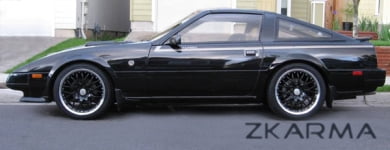How do you measure wheel bearing preload, per the fsm? or torque then crack it off?
-
 Z_KarmaAdministrator
Z_KarmaAdministrator- 3318
How do you measure wheel bearing preload, per the fsm? or torque then crack it off?
Just got the bearings for doing the rear stub axles in SS 820 and have a nitpick question about the procedure.
88 FSM:
FA-5: Procedure for the front:
So, you're supposed to torque to spec, crack it off a bit and use a scale to measure preload. Got it.
I just did mine and only cracked it off the 60deg without measuring/setting the preload.
RA-5: Procedure for the rear:
Torque to spec: 152-210 ft-lbs (which is a huge range). Then measure preload. No further procedure specified.
So would i assume that you torque it to the low end of the spec, check preload and then tighten incrementally if it is too easy to turn, checking each time?
OR
For those that have done it, did you just day fuck-it and torque it without messing about setting the preload.
The procedure for installation of the rear wheel bearings is pretty vague.
I have a dial guage fish scale that i think might work for setting the preload.
84 AE/Shiro #683/Shiro #820/84 Turbo -
 mtherkampSenior Member
mtherkampSenior Member- 243
I guess thats better that night-f*ing it? Lol just giving you crap. Because the bearings are not tapered, they don't rely on the preload to keep them running right. I suspect the specs are there just to make sure its not locked up around the "distance piece" (what a creative name :eyeroll: ). I personally didn't measure it, just hit nut with my big impact and called it good. Big disclaimer on this, my car is not back together yet, so no guarantees I did it right. (z31 lyfe)Originally posted by Z_Karma View Postdid you just day fuck-it and torque it without messing about setting the preload.Butter (credit where credit is due): "You have this "gift" where you can make cooking a Hot Pocket seem like you need a certain wavelength microwave and involve brown mustard." -
 DeepFriedRiceMember
DeepFriedRiceMember- 44
I didn't pre-load measure mine, just torque, back off about 40*, spin several rotations and repeat. Did this about 4-5 times on each side, just until every time I re-applied the torque the wrench was stopping at the same location. Have not had any problems. Haven't done the rears yet though, so no experience to share there. -
 mtherkampSenior Member
mtherkampSenior Member- 243
^yeah but the front bearings are very different, being tapered roller type. I'm telling you that the rear are VERY different than most "wheel" bearings and don't require a "preload setting" procedure… It is just there to make sure all the pieces went together properly. There should be very little resistance to spinning because the bearings don't use preload to hold together.Butter (credit where credit is due): "You have this "gift" where you can make cooking a Hot Pocket seem like you need a certain wavelength microwave and involve brown mustard." -
 Z_KarmaAdministrator
Z_KarmaAdministrator- 3318
That makes sense about tapered vs spherical bearings. The distance piece in effect, sets the preload.
day fuck-it…yeah i was dog-tired when i posted this.

84 AE/Shiro #683/Shiro #820/84 Turbo -
 adamvann3Senior Member
adamvann3Senior Member- 4160
I used the common sense mechanism when installing. Torque it down, check to ensure it spins (rinse and repeat as needed) and be done with it.
I also remember them being a huge PITA trying to get out.86na - BlueZ
Shiro #366 - Kouki Monster
85t - Mr Tickles -
 mtherkampSenior Member
mtherkampSenior Member- 243
^ yeah I rented a slide hammer with the "axle puller" attachment from O'Reilly's. Did the trick to get the stub axle out of the housing. The inner flange part I think I just beat on it with a hammer in a circular pattern until it removed itself.Butter (credit where credit is due): "You have this "gift" where you can make cooking a Hot Pocket seem like you need a certain wavelength microwave and involve brown mustard." -
 G-EJunior Member
G-EJunior Member- 6320
Steering wheel puller for the inner flange, sledgehammer for the axle stub
I find with a heavy sledge, the momentum it carries helps loosen it far more effectively than a small one or even air-hammer, especially if you can take the arm off: place wood blocks fore and aft of the hub, have someone hold the trailing arm from tipping over, one good hit with a sledge should do it
